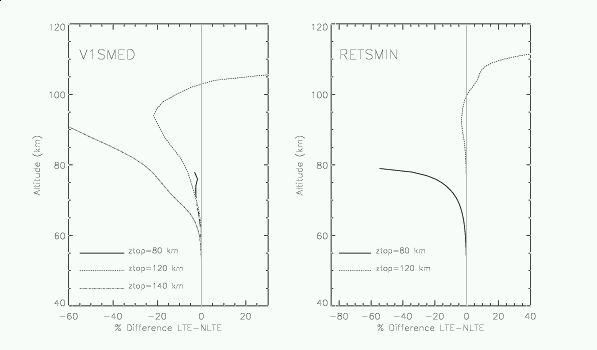|
PARAMETERIZATION OF NON-LTE EFFECTS FOR
GLOBAL CIRCULATION MODELS (GCM)
A very important application of our non-LTE models is the design and
implementation of fast schemes or parameterizations of the non-LTE effects
on the atmospheric radiation budget. The idea is to incorporate the non-LTE
effects on large physical models of the atmosphere, like the General
Circulation Models, or GCM in short. These codes solve the "primitive
equations" of dynamic meteorology in order to simulate and represent a large
number of physical processes that ocurr in the atmosphere.
One of the most important modules of the GCMs is the "radiative package",
or algorithm to compute the radiative cooling and heating terms that appear
in the thermodynamic equation. In the upper atmosphere the non-LTE effects
become important for such radiation budget, and must therefore be included
in the GCM to obtain correct predictions.
Our work may be divided in two parts. First, we studied the simpler problem
of the near-IR solar heating term, and then, we have moved to the other term,
the thermal cooling of the atmosphere in the IR.
SOLAR HEATING :
For the solar heating we have recently proposed a fast and simple tabulation
of the non-LTE effects, which can be used to correct for these effects easily
if an LTE calculation is available. We also tested this scheme in a Martian
GCM, that developed at the Mars General Circulation Modeling Group of NASA-Ames.
The results can be found in the papers:
Non-LTE in General Circulation Models of the Martian Atmosphere
1. Effects of the LTE approximation on the Thremal Cooling and Solar Heating
Lopez-Valverde et al., J. Geophys. Res.-Planets, 103, pp.16799-16811, 1998
Postscript File [ GUNzipped Tar files, 120 Kb ]
General circulation model simulations of the Mars Pathfinder ASI/MET Data
Haberle et al., J. Geophys. Res.-Planets, 104, pp.8957-8974, 1999
Abstract [ASCII text file]
The tabulation of the non-LTE effects as a function of pressure can be found
in the first of those papers. You can also get a copy here(DVI file, 7 Kbytes).
THERMAL COOLING :
We are currently studying parameterizations for the other term, the thermal
cooling by CO2 non-LTE emissions. Such work is the central part of our current
participation in an ESA project called CCN2, which, in collaboration with the
Laboratoire de Météorologie Dynamique (CNRS), at Paris, and with the Atmospheric,
Oceanic and Planetary Physics Department of the Oxford University, is aimed at
improving and extending the European Martian Climate Database.
There is a www page with the relevant Technical Documentation of this project,
and with the preliminary results.
We will report on our progresses eventually in this section.
An illustration of the importance of non-LTE on the cooling rates is
the following figure, taken from the work by Lopez-Valverde et al.,
JGR-Planets, pp.16799-16811, 1998, which shows the non-LTE effects on the
CO2 thermal cooling rate at 15 um for two different atmospheres and at
different altitudes.
 Figure 1.
Percentage difference between LTE and non-LTE cooling rates for several top
altitudes z_top and for the two reference atmospheres V1SMED and RETSMIN.
Figure 1.
Percentage difference between LTE and non-LTE cooling rates for several top
altitudes z_top and for the two reference atmospheres V1SMED and RETSMIN.
|






